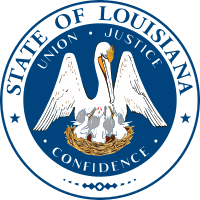Politics of Louisiana
 |
|---|
| This article is part of a series on the politics and government of Louisiana |
|
Executive |
|
|
See also: List of United States Senators from Louisiana
|
|
The Politics of Louisiana are known for its entrenched corruption and populism. The State has toggled between Democratic and Republican control since the civil war, and has reliably supported populist candidates of all stripes, including Donald Trump, Huey Long, Earl Long, David Duke, and George Wallace. Other distinct features of Louisiana's politics include its calcified aristocracy, use of the Napoleonic Code (instead of English Common Law, like the rest of the U.S.), history of white supremacy, and the divide between Catholics in the south and Evangelical Protestants in the north.
Rising Republicanism
In the decades following the beginning of the Civil Rights Movement and a concomitant reaction against cultural liberalism, the Republican Party gained strength in the conservative suburbs of New Orleans and Baton Rouge and for a time in Caddo Parish. The GOP over a long period of time drew increasing support among rural voters elsewhere, including parts of North Louisiana and Southeast Louisiana. These patterns follow trends in other southern states as white control of state Democratic Party structures weakened and the region became more diverse and more prone to adopt the two-party behavior characteristic of most the nation.[1]
The political balance in Louisiana will likely be affected by the post-Hurricane Katrina exodus from New Orleans. Heavily Democratic New Orleans lost much of its population, and many of the former residents have not returned. The overall effect likely reduces Democrats' base of support in the state and could make Louisiana a Republican-leaning state in the future. Nevertheless, Democratic Lieutenant Governor Mitch Landrieu was elected overwhelmingly as mayor of New Orleans in February 2010.
Even in the early 20th century, Louisiana had a pocket of Republican strength centered about the sugar parishes west of New Orleans, where farmers favored the GOP's position on protective tariffs. According to The Louisiana Elections of 1960, whose authors include the late Louisiana State University sociologist Perry H. Howard, from 1920, the year of the election of Warren G. Harding as U.S. President until 1956, the reelection of Dwight D. Eisenhower, "a number of parishes, many in close proximity, have consistently supported the Republican party at close to or significantly above the presidential Republican vote average. Apart from some of the urbanized parishes, the majority of these parishes are in south Louisiana; in fact, they form a cluster in the sugar cultivation area west of the Atchafalaya swamp and along Bayou Lafourche and the Mississippi River below Baton Rouge."."[2]
In time, Republicanism took root in the Shreveport-Bossier City area of northwest Louisiana, with increasing strength added from Ouachita, Lincoln, Rapides, East Baton Rouge, and Lafayette parshes plus most of the suburban parishes about New Orleans. One of the small Republican-leaning parishes is La Salle in North Louisiana. Still another is predominantly white West Carroll Parish.
Since the construction of the Lake Pontchartrain Causeway in the mid-1950s, the Northshore Region began demonstrating increasingly Republican leanings, first and most notably in Saint Tammany Parish, which as of 2010 has the highest percentage of Republican voters by registration in Louisiana. It was the first parish since the Reconstruction Era to make the Democrats merely a plurality and the first to experience a Republican majority.
In the 2008 elections, Louisiana sent a mixed result, with the election of U.S. Senator John McCain for President and the reelection of Democratic U.S. Senator Mary Landrieu. The other senator is Republican David Vitter. Republicans hold six of the seven U.S. Representative seats from Louisiana. By contrast, in 1960, not a single Republican served in either house of the Louisiana legislature. The first Republicans to serve in the legislature since Reconstruction were not elected until 1964, and both—Morley A. Hudson and Taylor W. O'Hearn—came from Shreveport. In 2010, several Democrats switched parties bringing the state house under Republican control. In 2011, the special election victories of Fred Mills and Jonathan Perry switched the balance of power in the state senate, leaving Republicans in control of the state legislature for the first time since Reconstruction. Also the party switch of Attorney General Buddy Caldwell caused the Republican party to control every statewide office. However, this was broken in 2015, when Democrat John Bel Edwards won the governor's race.
Tolerance for corruption
Louisiana was long known for its toleration of corruption in government. Bill Dodd, former lieutenant governor and education superintendent, in his book Peapatch Politics: The Earl Long Era in Louisiana Politics describes corruption as "a way of life, inherited, and made quasi-respectable and legal by the French freebooters who founded, operated, and left us as the governmental blueprint that is still Louisiana's constitutional and civil law." Dodd notes furthermore that some attribute the corruption to "outlaws, gamblers, and fortune hunters who came off the mountains and down the Mississippi River to add their flavor to the Louisiana pot. A sizable minority thinks corruption was made worse by slavery and the granting of full civil rights and privileges to blacks before these heretofore de facto slaves could or would assume and fulfill their personal and legal responsibilities."[3]
See also
References
- ↑ See White primary.
- ↑ William C. Havard, Rudolf Heberle, and Perry H. Howard, The Louisiana Elections of 1960, Baton Rouge: Louisiana State University Studies, 1963, p. 59
- ↑ Bill Dodd, Peapatch Politics: The Earl Long Era in Louisiana Politics (Baton Rouge: Claitor's Publishing Company, 1991), p. 8
External links
- Politics of Louisiana at Curlie (based on DMOZ)